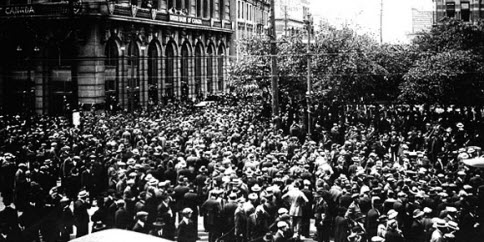by Bruce Cherney (part 3)
On September 11, 1902, a band wooed another standing-room-only crowd in Victoria Park at the foot of Rupert Avenue. In a next day description of the event, the Manitoba Free Press reported that an arc light shone upon the musicians’ benches with such intensity, “dispelling the gloom from the whole park.”
Surprisingly, despite the public park’s obvious popularity, there were continual plans afoot to use it for another purpose.
One of the initial suggestions was made in 1902, when it was proposed that Victoria Park be used as the site of the city’s first Carnegie Library.
Andrew Carnegie was a Scottish-born American steel magnate, who devoted most of his considerable fortune to philanthropy, including the establishment of libraries across the U.S. and the British Empire.
“In 1901, provincial librarian J. P. Robertson wrote to American philanthropist Andrew Carnegie to request that Winnipeg be given a grant similar to that provided to Ottawa for the construction of a library. In due course, Carnegie donated $75,000,” the only provision was that the city had to provide the land for the library (Manitoba Historical Society, Historic Sites of Manitoba: Carnegie Library).
J.F. Mitchell wrote to the Free Press on May 9, 1902, claiming Victoria Park was an ideal location for the new public library, since streetcars from every part of the city passed nearby. “If the building was placed in the centre of the park it would stand directly in front of Rupert Street and give a fine view of Main street,” as well as the Red River, according to Mitchell.
The letter writer further stated that the library would only take up a small section of the park, “and would add its beauty and the splendid large shade trees that surround it would be a boon to the readers in the hot summer days.”
The newspaper held a readers’ poll which suggested Victoria Park was among the heavily-favoured sites for the library.
The Winnipeg Tribune reported on May 10 that a delegation of prominent citizens visited the park and concluded it was the “most desirable location” for the library.
Public meetings were also held, which discussed various locations, including St. John’s and Victoria parks and the old Grand Union Hotel property at the corner of Ross Avenue and Princess Street.
Victoria Park was spared from another intrusion on its space when $25,000 was set aside in 1902 to assemble land and for landscaping at 380 William Ave. Winnipeg’s first proper public library — reading rooms operated by private groups and organizations had been used as make-do facilities prior to its construction — opened in 1905.
Between 1906 and 1910, Victoria Park faced another threat, when it was mentioned as the favoured site for public baths, a term then used for a building combining a swimming pool, baths and showers.
Actually, the first proposal for public baths came from the private sector, rather than the city, which would soon afterward solely take on the promotion of such a facility.
The September 5, 1906, Tribune reported that E.F. Hutchings of the Manitoba Exploration Co. wanted to use Victoria Park for public baths that would be supplied with salt water from a well being drilled in St. Boniface. He also proposed a different method of funding, as opposed to a strictly private-sector project that had been the company’s original intention.
“The gentlemen who constitute the Exploration company (Drs. Carscallen and White were also partners) have asked for a public appropriation of $25,000 to assist in building the salt baths, which they believe will give the best service.”
“We at first thought of building the baths as a private business proposition,” explained Hutchings, “but as we looked into the matter further it seemed to be so much a thing for public interest and public welfare, and to be, withal, so large an undertaking to fit up the baths upon a scale large enough to supply the needs of the city’s population, that we conceived the plan of asking for an appropriation of public money and a location in a public park in order that the baths may be easily accessible and thoroughly equipped for the use of all ...”
(Next week: part 4)



